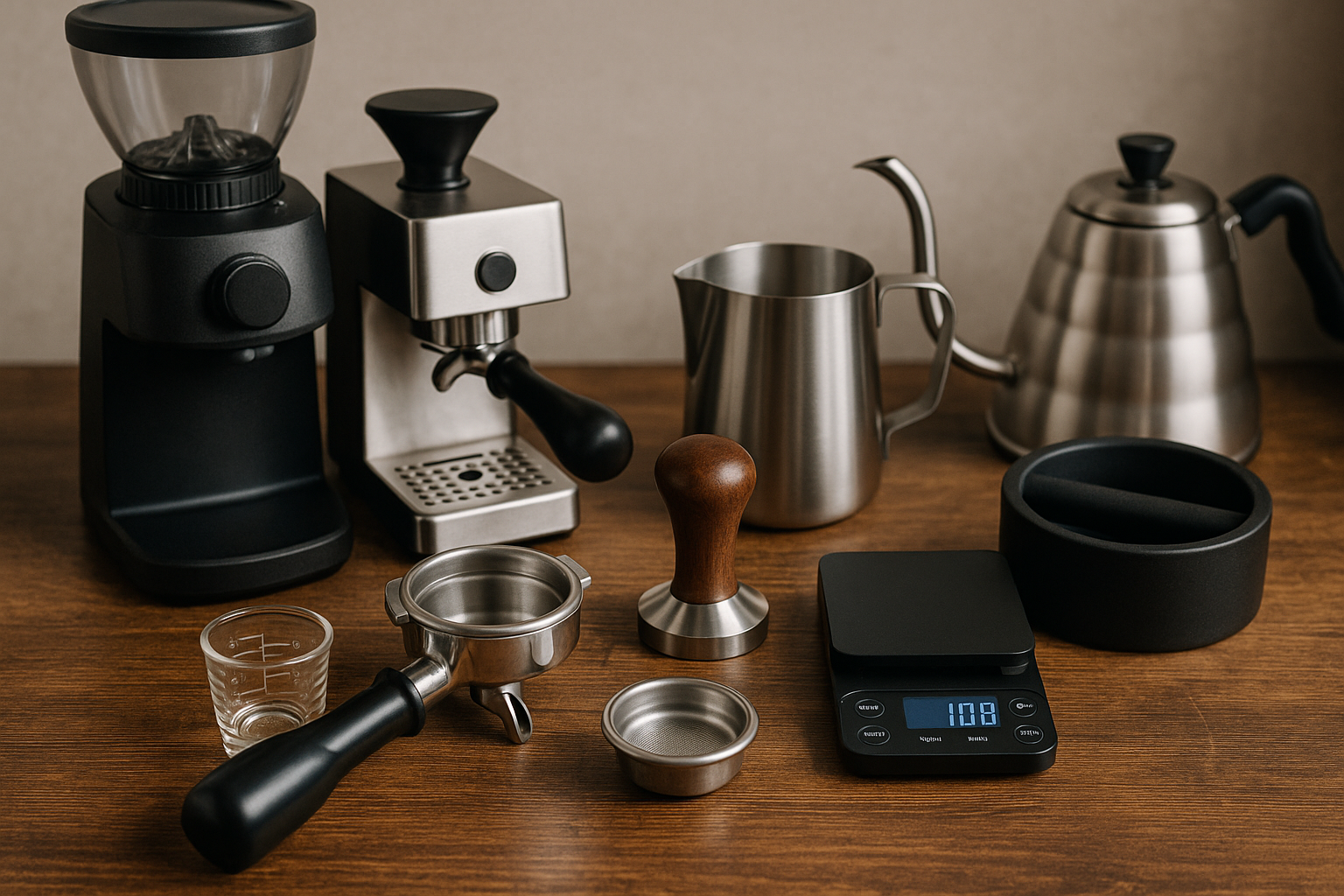Becoming a skilled barista is not just about technique—it also requires the right tools. The best baristas know that consistency, precision, and quality are only achievable with the right equipment.
Whether you’re working in a café or creating coffee at home, investing in the essentials will elevate every cup you make and streamline your workflow for speed and control.
While it’s tempting to buy every gadget on the market, it’s important to focus on tools that actually improve your brewing.
From grinders to tampers, scales to steam wands, every item on your bench should serve a purpose. A good setup helps you maintain standards, correct mistakes, and build a reliable daily routine around coffee preparation.
Espresso Machine: The Heart of the Barista Station
Your espresso machine is the foundation of your entire barista toolkit. It’s where pressure meets precision to create concentrated, flavorful coffee.
For serious baristas, a quality semi-automatic or manual machine is a must. These machines allow for control over variables like water temperature, pre-infusion time, and shot volume.
Entry-level machines are affordable, but often limit customization. Higher-end models from brands like La Marzocco, Slayer, or Rocket offer PID temperature control, dual boilers, and better thermal stability.
For beginners at home, machines from Breville or Gaggia offer great performance without breaking the bank.
Coffee Grinder: Control Begins With the Grind
A consistent grinder is more important than the espresso machine itself. Why? Because grind size affects flow rate, extraction balance, and ultimately, taste.
Burr grinders are essential—they crush beans uniformly, allowing water to extract flavor evenly from all particles.
Stepless grinders allow fine adjustment, giving you the precision needed to dial in espresso. Look for models with minimal grind retention and easy cleaning.
A good barista knows that switching beans or roast levels often requires changing grind settings, and your grinder should respond without struggle.
Tamper: Precision in Every Press
Tamping compresses the coffee bed to ensure even resistance during extraction. A high-quality tamper should match the diameter of your portafilter basket—usually 58mm—and feel ergonomic in your hand. Look for solid metal construction and a flat or slightly convex base.
Some baristas prefer calibrated tampers that click at a certain pressure. These ensure consistency, especially in high-volume environments.
Others favor palm tampers or pressure-regulated handles for speed. Whichever style you choose, make sure you tamp level and firmly every time.
Distribution Tools: Even Coffee = Better Shots
Even before tamping, you need to ensure the coffee grounds are level. Distribution tools (or WDT tools) help break up clumps and spread grounds evenly across the basket.
This prevents channeling—where water takes uneven paths through the puck—and boosts shot consistency.
Basic distribution tools cost very little and can dramatically improve your extraction. More advanced ones allow adjustable depths and spinning motion to level grounds perfectly. Use one right after grinding, before tamping, and you’ll instantly see improvements in shot clarity.
Portafilter and Baskets
Your portafilter is the handle that holds the coffee during extraction. It should be made of heavy-duty brass or stainless steel to retain heat.
Most cafés use bottomless portafilters, which show you the extraction and help diagnose channeling or tamping issues in real time.
The basket inside the portafilter matters too. Precision baskets from companies like VST or IMS have tighter manufacturing tolerances, ensuring consistent flow.
These baskets are designed to work best at specific doses (like 18g or 20g), so always match your recipe to the basket volume.
Scales: Accuracy Matters
Digital scales are one of the most underrated tools for baristas. Measuring your dose and yield ensures consistency from shot to shot.
In espresso, even 0.1g can make a noticeable difference in flavor, so accuracy is key. Use scales to weigh both the input (coffee) and output (espresso).
For espresso, choose a fast, compact scale with a timer and high precision. The Acaia Lunar is a favorite in cafés.
For pour-over, a larger scale like the Timemore Black Mirror provides more surface area and excellent responsiveness. Remember: what gets measured, gets improved.
Steam Wand and Milk Pitchers
For milk-based drinks, steaming milk correctly is just as important as pulling a good shot. A high-quality steam wand with strong pressure and fine tip control helps create the microfoam needed for latte art.
Learn to position the wand properly and introduce air gently at the beginning of the steaming process.
Milk pitchers should be stainless steel with a pointed spout. This shape helps with latte art precision. Keep at least two sizes (12oz and 20oz) to handle different drink volumes.
Practice with cold milk and clean your pitcher and steam wand after every use to maintain hygiene and texture quality.
Thermometer: Precision in Milk Steaming
While experienced baristas learn to steam milk by touch, beginners benefit from a thermometer. Milk should be steamed to around 60–65°C (140–150°F) for optimal sweetness and texture.
Too hot, and you scald the milk proteins; too cool, and the drink lacks flavor and body.
Clip-on thermometers are affordable and help train your instincts. Eventually, you’ll learn to recognize the right temperature by feel, but until then, don’t skip this tool. It also builds customer trust by showing attention to detail.
Knock Box: Clean Workflow, Happy Barista
A knock box is where spent coffee pucks are discarded. It’s an essential part of keeping your station clean and efficient. Instead of walking to the trash every time, you can knock out the portafilter with one hand and move on to the next shot.
Choose a knock box with a sturdy rubber bar and non-slip base. In cafés, you’ll often see large knock drawers built into the counter. At home, smaller countertop models are perfect. Always empty and rinse it regularly to avoid mold or foul smells.
Cleaning Tools: Don’t Skip This Part
A clean machine makes better coffee. Every barista should have a set of cleaning tools: brushes for the group head, backflushing detergent like Cafiza, microfiber cloths for steam wands, and cleaning tablets if your machine requires them.
Daily maintenance includes backflushing, wiping portafilters, and rinsing pitchers. Weekly cleaning involves deeper tasks like descaling and removing shower screens. Good coffee starts with clean equipment—never underestimate this habit.
Shot Glasses and Measuring Cups
Shot glasses aren’t just for aesthetics. They help you monitor shot volume, color, and crema development. Use double-spouted glasses marked in milliliters and ounces for consistent output.
Baristas often develop a visual sense of whether a shot is running too fast or too slow just by watching the stream.
Measuring cups with pour spouts are also helpful when making drinks with milk or syrups. A proper set of glassware enhances workflow, minimizes waste, and improves drink presentation. Professional tools make a professional impression.
Timer or Built-In Timers
Timing your shot is critical in espresso brewing. While many machines have built-in timers, using a separate stopwatch or scale with a timer feature is still common in cafés. Knowing your shot time helps diagnose issues and replicate great results.
The classic target is 25–30 seconds for a double shot. If your shot is too fast or too slow, adjust your grind. Don’t guess—track time. Over time, you’ll learn to intuitively link shot time with flavor profile, and that builds real barista skill.
Optional Tools for Advanced Baristas
Once you master the essentials, consider exploring advanced tools. Pressure profiling machines let you vary the extraction pressure during the shot.
Flow control devices let you mimic lever-machine behavior. Puck screens distribute water more evenly and reduce channeling. Distribution tools with variable depth offer unparalleled consistency.
Not all of these are necessary for beginners, but they’re valuable for learning and experimentation. They push your understanding deeper and allow you to customize your coffee experience further. The tools evolve as your skills do.
Building Your Barista Station at Home
If you’re building a home setup, start with the essentials: a good grinder, reliable machine, precise scale, and proper tamper. Add tools gradually as your technique improves. Avoid cheap gadgets that clutter your counter but don’t contribute to quality.
Keep your station organized and clean. Use storage trays, labeled containers for beans, and regular maintenance routines. Professionalism isn’t about space—it’s about consistency and care. Whether you’re brewing for one or a hundred, your tools reflect your standards.
Conclusion: Tools That Empower Craft
Great coffee isn’t magic—it’s the result of attention, knowledge, and the right equipment. Each tool on your bench should serve a purpose, reduce guesswork, and help you grow in consistency and confidence. The more you master your tools, the more freedom you have to experiment, adjust, and refine your brew.
Barista tools don’t replace skill, but they support it. With the right setup, every cup becomes an opportunity to learn and to serve something truly exceptional.

Marcelo Oliveira is a coffee enthusiast and content creator specializing in barista skills, brewing methods, equipment reviews, coffee-related health insights, and fascinating curiosities from the coffee world. With a deep passion for every step of the brewing process, he turns technical knowledge into accessible and engaging content for both beginners and seasoned coffee lovers. Marcelo’s goal is to help readers appreciate the full experience of coffee—from bean to cup.
